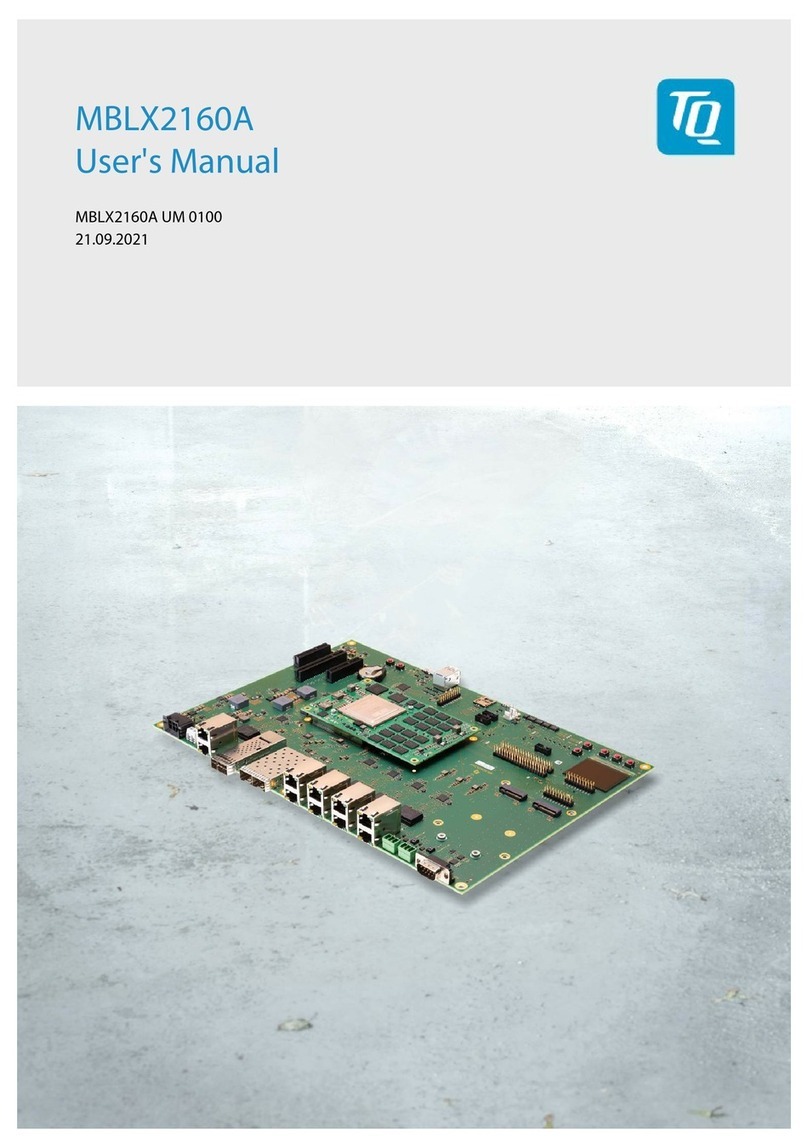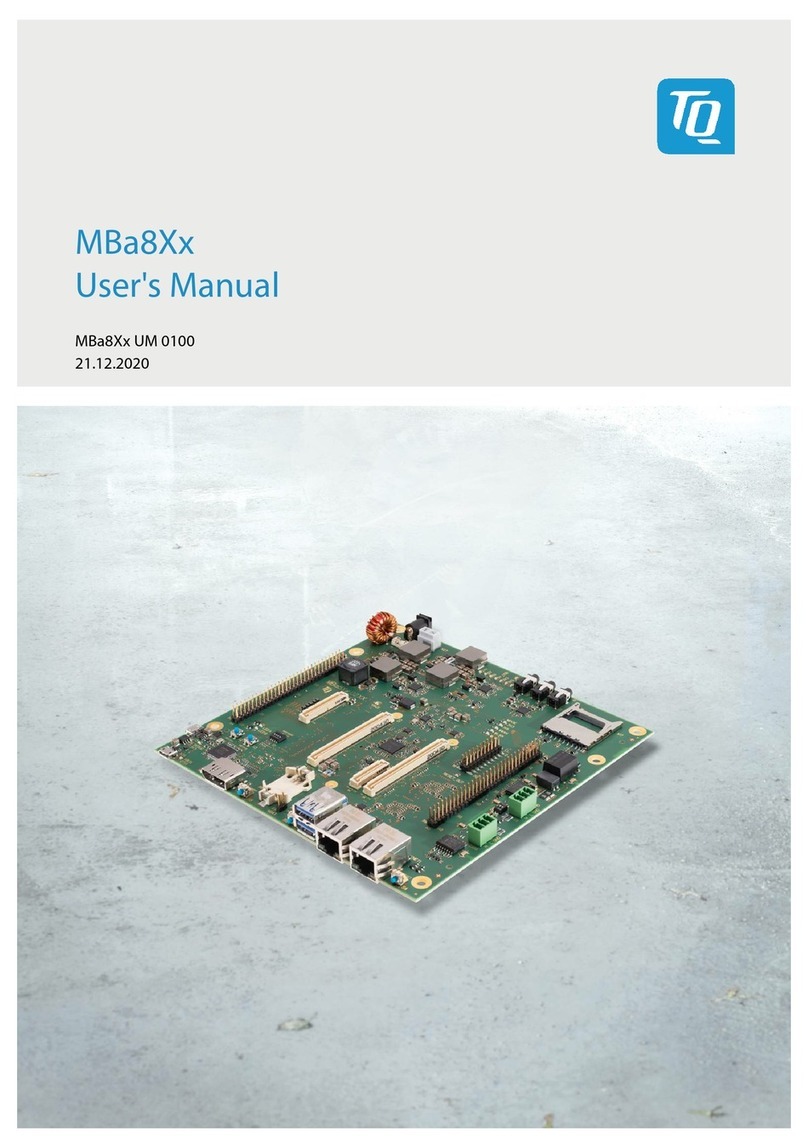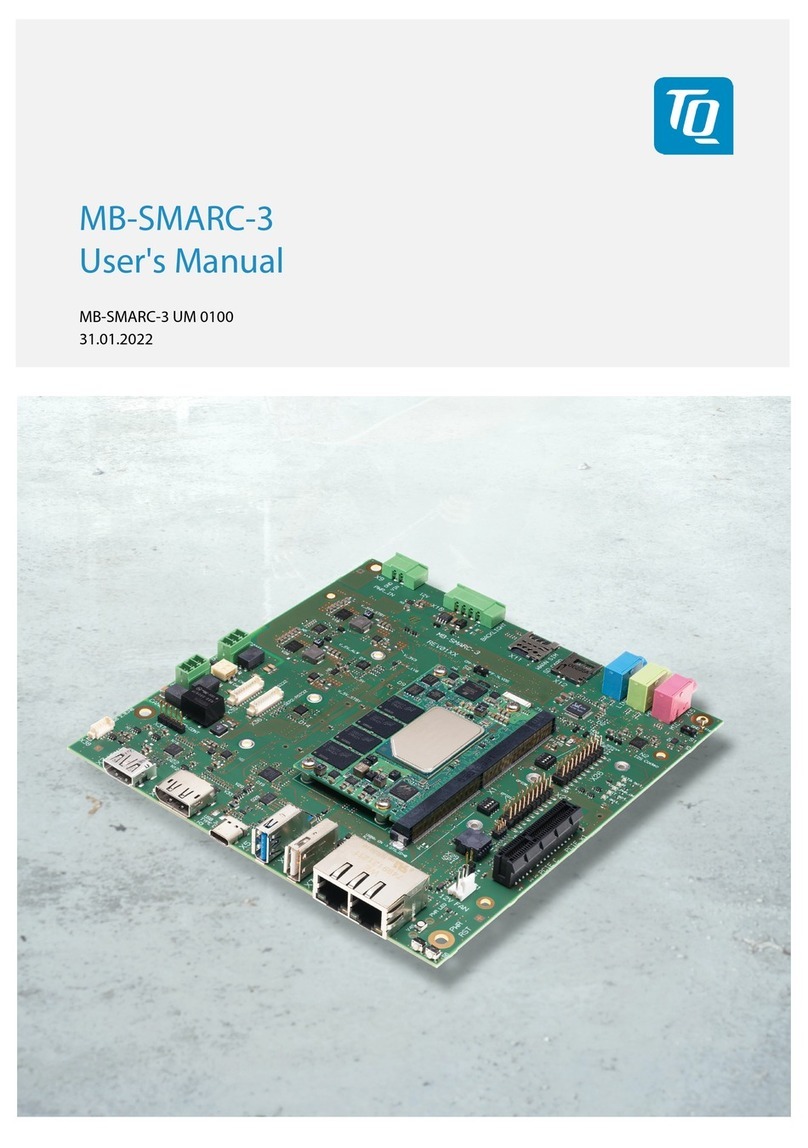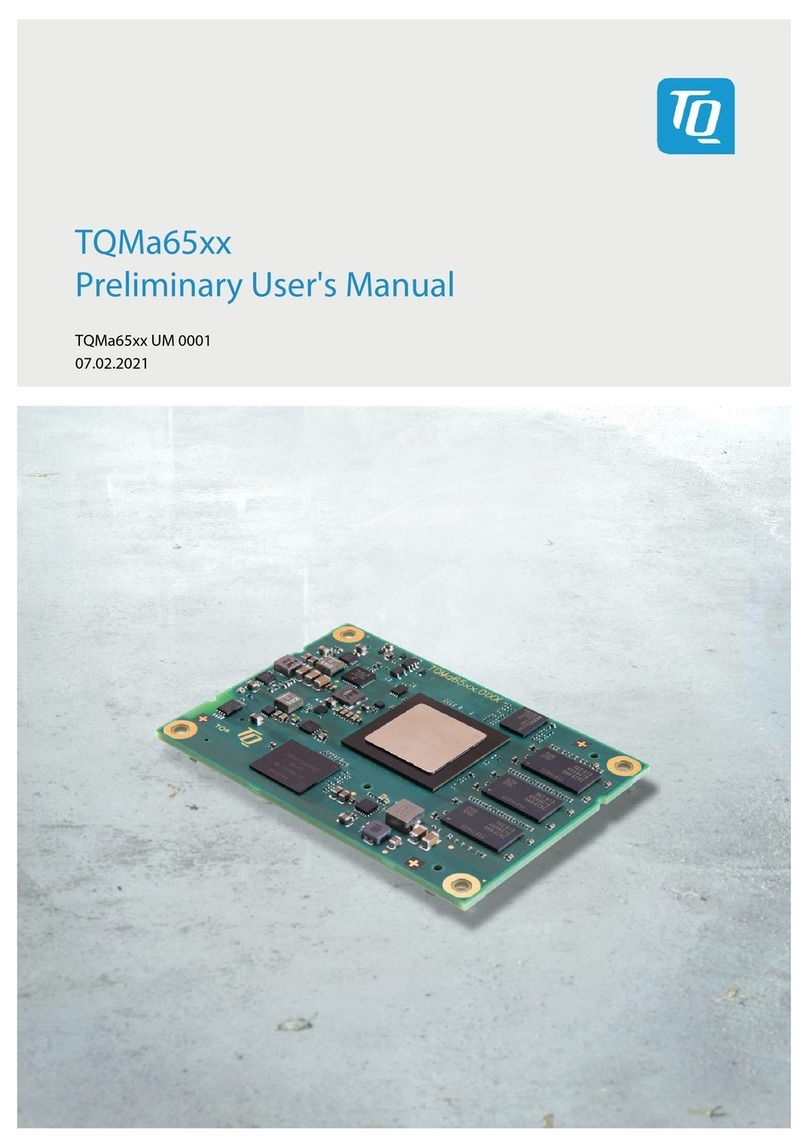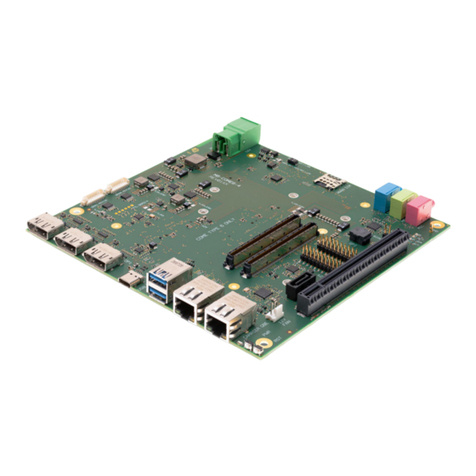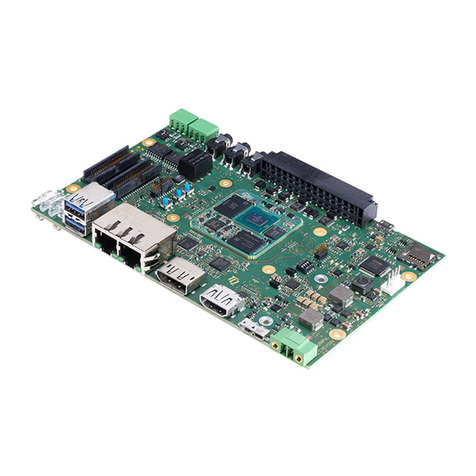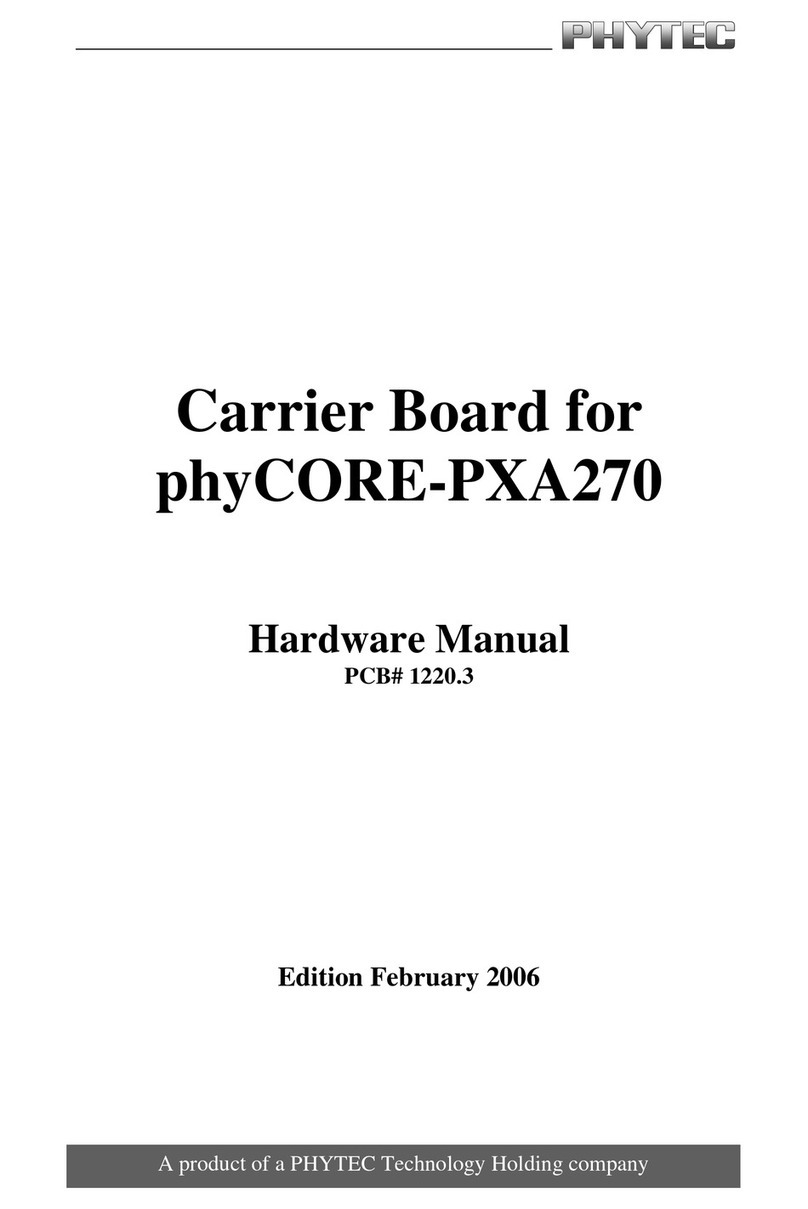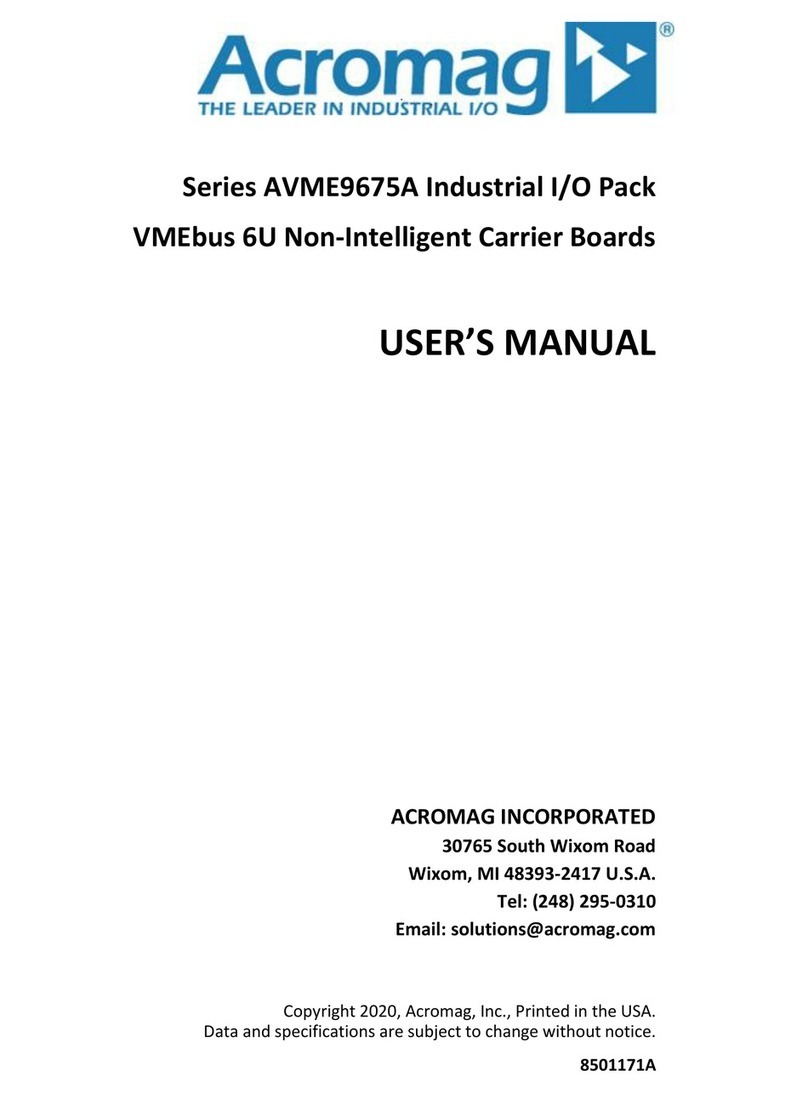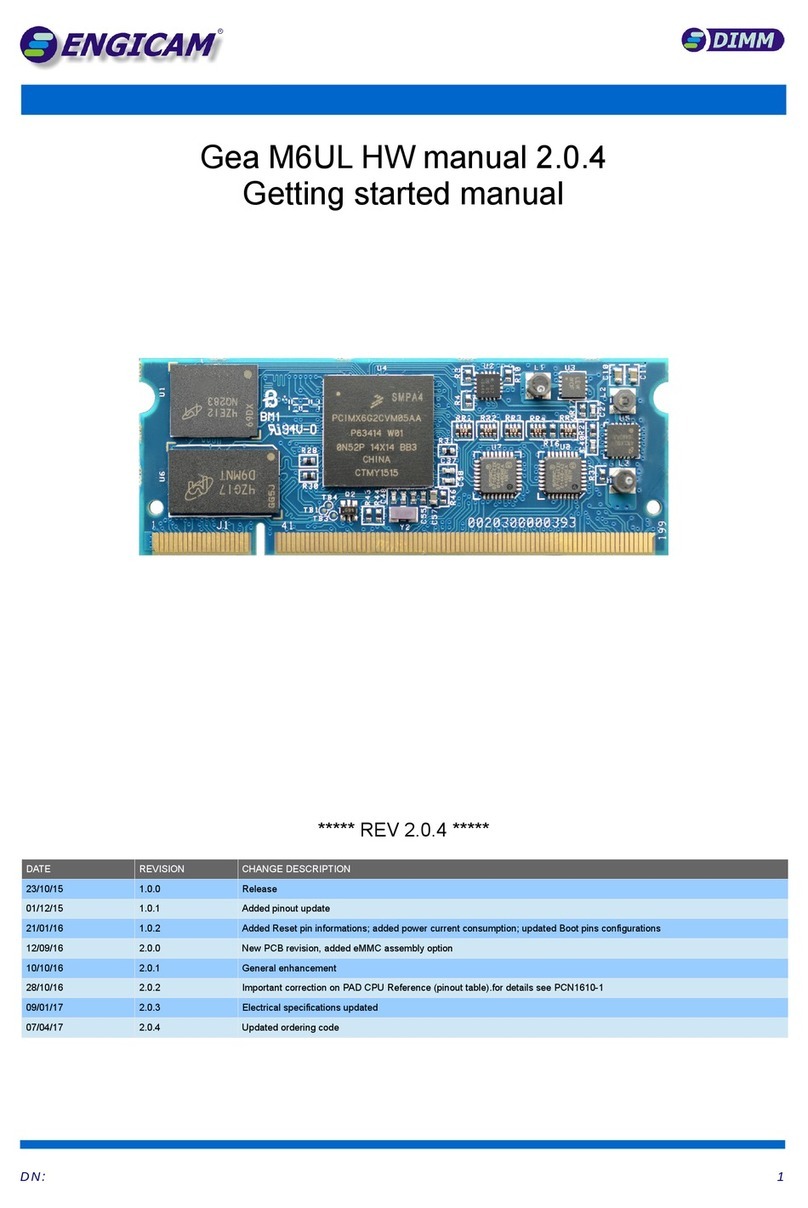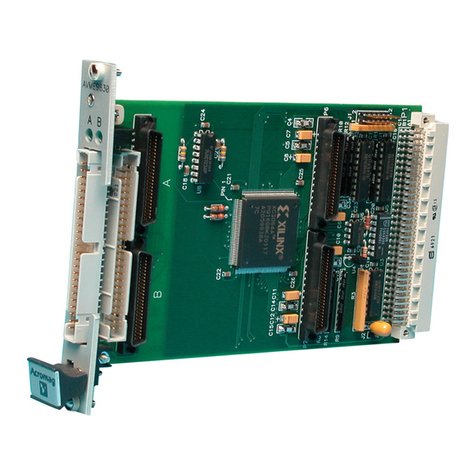TQ TQMLX2160A User manual

TQMLX2160A
User’s Manual
TQMLX2160A UM 0100
28.02.2022

User’s Manual l TQMLX2160A UM 0100 l © 2022, TQ-Systems GmbH Page i
TABLE OF CONTENTS
1. ABOUT THIS MANUAL................................................................................................................................................................................1
1.1 Copyright and license expenses.............................................................................................................................................................1
1.2 Registered trademarks...............................................................................................................................................................................1
1.3 Disclaimer......................................................................................................................................................................................................1
1.4 Imprint............................................................................................................................................................................................................1
1.5 Tips on safety................................................................................................................................................................................................2
1.6 Symbols and typographic conventions ...............................................................................................................................................2
1.7 Handling and ESD tips...............................................................................................................................................................................2
1.8 Naming of signals........................................................................................................................................................................................3
1.9 Further applicable documents / presumed knowledge .................................................................................................................3
2. BRIEF DESCRIPTION ....................................................................................................................................................................................4
3. OVERVIEW......................................................................................................................................................................................................5
3.1 Block diagram...............................................................................................................................................................................................5
3.2 System components...................................................................................................................................................................................5
4. ELECTRONICS................................................................................................................................................................................................6
4.1 Processor variants .......................................................................................................................................................................................6
4.2 Reset structure .............................................................................................................................................................................................7
4.2.1 TQMLX_RST# ................................................................................................................................................................................................7
4.2.2 HRESET# .........................................................................................................................................................................................................7
4.2.3 RESET_REQ#..................................................................................................................................................................................................7
4.2.4 LX_CPU_RESET_OUT#................................................................................................................................................................................7
4.2.5 JTAG_TRST# ..................................................................................................................................................................................................7
4.3 Boot source ...................................................................................................................................................................................................8
4.4 DDR4 SDRAM................................................................................................................................................................................................8
4.5 NOR flash, eMMC / SD card ......................................................................................................................................................................8
4.6 EEPROMs........................................................................................................................................................................................................9
4.6.1 EEPROM, 24LC64 .........................................................................................................................................................................................9
4.6.2 Temperature sensor with EEPROM, SE97B..........................................................................................................................................9
4.6.2.1 Temperature sensor, SE97B .....................................................................................................................................................................9
4.6.2.2 EEPROM, SE97B......................................................................................................................................................................................... 10
4.7 RTC................................................................................................................................................................................................................ 10
4.8 Secure Element ......................................................................................................................................................................................... 11
4.9 Interfaces .................................................................................................................................................................................................... 12
4.9.1 SerDes.......................................................................................................................................................................................................... 12
4.9.2 I2C bus.......................................................................................................................................................................................................... 13
4.9.3 UART............................................................................................................................................................................................................. 14
4.9.4 USB................................................................................................................................................................................................................ 14
4.9.5 RGMII............................................................................................................................................................................................................ 14
4.9.6 JTAG.............................................................................................................................................................................................................. 14
4.10 Power supply............................................................................................................................................................................................. 15
4.10.1 Input voltage ............................................................................................................................................................................................. 15
4.10.2 Voltage monitoring ................................................................................................................................................................................. 15
4.10.3 Power consumption................................................................................................................................................................................ 15
4.11 TQMLX2160A connectivity.................................................................................................................................................................... 15
4.11.1 Interface impedances ............................................................................................................................................................................. 15
4.11.2 SerDes track length.................................................................................................................................................................................. 16
4.11.3 Pin multiplexing ....................................................................................................................................................................................... 17
4.11.4 Pinout TQMLX2160A connectors........................................................................................................................................................ 18
5. MECHANICS................................................................................................................................................................................................ 23
5.1 TQMLX2160A assembly.......................................................................................................................................................................... 23
5.2 TQMLX2160A weight, dimensions...................................................................................................................................................... 24
5.3 TQMLX2160A connectors...................................................................................................................................................................... 26
5.4 Protection against external effects..................................................................................................................................................... 26
5.5 Thermal management............................................................................................................................................................................ 27
5.6 Structural requirements......................................................................................................................................................................... 27
5.7 Notes of treatment................................................................................................................................................................................... 27
6. SOFTWARE.................................................................................................................................................................................................. 27
7. SAFETY REQUIREMENTS AND PROTECTIVE REGULATIONS......................................................................................................... 28
7.1 EMC............................................................................................................................................................................................................... 28
7.2 ESD................................................................................................................................................................................................................ 28
7.3 Operational safety and personal security......................................................................................................................................... 28

User’s Manual l TQMLX2160A UM 0100 l © 2022, TQ-Systems GmbH Page ii
7.4 Climatic and operational conditions.................................................................................................................................................. 28
7.5 Reliability and service life....................................................................................................................................................................... 28
8. ENVIRONMENT PROTECTION................................................................................................................................................................ 29
8.1 RoHS ............................................................................................................................................................................................................. 29
8.2 WEEE®.......................................................................................................................................................................................................... 29
8.3 REACH®........................................................................................................................................................................................................ 29
8.4 EuP ................................................................................................................................................................................................................ 29
8.5 Battery.......................................................................................................................................................................................................... 29
8.6 Packaging ................................................................................................................................................................................................... 29
8.7 Other entries.............................................................................................................................................................................................. 29
9. APPENDIX ................................................................................................................................................................................................... 30
9.1 Acronyms and definitions...................................................................................................................................................................... 30
9.2 References.................................................................................................................................................................................................. 31

User’s Manual l TQMLX2160A UM 0100 l © 2022, TQ-Systems GmbH Page iii
TABLE DIRECTORY
Table 1: Terms and Conventions ............................................................................................................................................................................2
Table 2: Boot source selection.................................................................................................................................................................................8
Table 3: eMMC_SEL0/1 signals................................................................................................................................................................................8
Table 4: eMMC Modes................................................................................................................................................................................................9
Table 5: TQMLX2160A-specific data in the EEPROM ..................................................................................................................................... 10
Table 6: SerDes Block 1 muxing options........................................................................................................................................................... 12
Table 7: SerDes Block 2 muxing options........................................................................................................................................................... 12
Table 8: SerDes Block 3 muxing options........................................................................................................................................................... 12
Table 9: I2C addresses.............................................................................................................................................................................................. 13
Table 10: TQMLX2160A power consumption @ 5 V......................................................................................................................................... 15
Table 11: TQMLX2160A interface impedances.................................................................................................................................................. 15
Table 12: SerDes track length and estimated insertion loss.......................................................................................................................... 16
Table 13: Pinout connector X1................................................................................................................................................................................ 18
Table 14: Pinout connector X2................................................................................................................................................................................ 19
Table 15: Pinout connector X3................................................................................................................................................................................ 21
Table 16: Labels on TQMLX2160A ......................................................................................................................................................................... 23
Table 17: TQMLX2160A side view dimensions.................................................................................................................................................. 24
Table 18: Connector assembled on TQMLX2160A........................................................................................................................................... 26
Table 19: Carrier board mating connectors........................................................................................................................................................ 26
Table 20: Climate and operational conditions................................................................................................................................................... 28
Table 21: Acronyms.................................................................................................................................................................................................... 30
Table 22: Further applicable documents............................................................................................................................................................. 31
FIGURE DIRECTORY
Figure 1: Block diagram TQMLX2160A (simplified)............................................................................................................................................5
Figure 2: Block diagram LX2160A ............................................................................................................................................................................6
Figure 3: Block diagram LX2120A ............................................................................................................................................................................6
Figure 4: Block diagram LX2080A ............................................................................................................................................................................6
Figure 5: Block diagram Reset structure ................................................................................................................................................................7
Figure 6: Block diagram NOR flash interface ........................................................................................................................................................8
Figure 7: Block diagram I2C1 EEPROM interface .................................................................................................................................................9
Figure 8: Block diagram RTC interface................................................................................................................................................................. 10
Figure 9: Block diagram SEC interface................................................................................................................................................................. 11
Figure 10: Block diagram I2C bus 1 structure on TQMLX2160A ..................................................................................................................... 13
Figure 11: Block diagram JTAG interface............................................................................................................................................................... 14
Figure 12: TQMLX2160A assembly, top................................................................................................................................................................. 23
Figure 13: TQMLX2160A assembly, bottom......................................................................................................................................................... 23
Figure 14: TQMLX2160A dimensions, side view................................................................................................................................................. 24
Figure 15: TQMLX2160A dimensions, top view .................................................................................................................................................. 25
Figure 16: TQMLX2160A dimensions, top view through TQMLX2160A...................................................................................................... 25

User’s Manual l TQMLX2160A UM 0100 l © 2022, TQ-Systems GmbH Page iv
REVISION HISTORY
Rev. Date Name Pos. Modification
0100 28.02.2022 Kreuzer First edition

User’s Manual l TQMLX2160A UM 0100 l © 2022, TQ-Systems GmbH Page 1
1.
ABOUT THIS MANUAL
1.1
Copyright and license expenses
Copyright protected © 2022 by TQ-Systems GmbH.
This User’s Manual may not be copied, reproduced, translated, changed or distributed, completely or partially in electronic,
machine readable, or in any other form without the written consent of TQ-Systems GmbH.
The drivers and utilities for the components used as well as the BIOS are subject to the copyrights of the respective
manufacturers. The licence conditions of the respective manufacturer are to be adhered to.
Bootloader-licence expenses are paid by TQ-Systems GmbH and are included in the price.
Licence expenses for the operating system and applications are not taken into consideration and must be calculated / declared
separately.
1.2
Registered trademarks
TQ-Systems GmbH aims to adhere to copyrights of all graphics and texts used in all publications, and strives to use original
or license-free graphics and texts.
All brand names and trademarks mentioned in this User’s Manual, including those protected by a third party, unless specified
otherwise in writing, are subjected to the specifications of the current copyright laws and the proprietary laws of the present
registered proprietor without any limitation. One should conclude that brand and trademarks are rightly protected by a third
party.
1.3
Disclaimer
TQ-Systems GmbH does not guarantee that the information in this User’s Manual is up-to-date, correct, complete or of good
quality. Nor does TQ-Systems GmbH assume guarantee for further usage of the information. Liability claims against TQ-Systems
GmbH, referring to material or non-material related damages caused, due to usage or non-usage of the information given in this
User’s Manual, or due to usage of erroneous or incomplete information, are exempted, as long as there is no proven intentional
or negligent fault of TQ-Systems GmbH.
TQ-Systems GmbH explicitly reserves the rights to change or add to the contents of this User’s Manual or parts of it without
special notification.
Important Notice:
Before using the Starterkit MBLX2160A or parts of the schematics of the MBLX2160A, you must evaluate it and determine if it is
suitable for your intended application. You assume all risks and liability associated with such use. TQ-Systems GmbH makes no
other warranties including, but not limited to, any implied warranty of merchantability or fitness for a particular purpose. Except
where prohibited by law, TQ-Systems GmbH will not be liable for any indirect, special, incidental or consequential loss or damage
arising from the usage of the Starterkit MBLX2160A or schematics used, regardless of the legal theory asserted.
1.4
Imprint
TQ-Systems GmbH
Gut Delling, Mühlstraße 2
D-82229 Seefeld
Tel: +49 8153 9308–0
Fax: +49 8153 9308–4223
E-Mail: Info@TQ-Group
Web: TQ-Group

User’s Manual l TQMLX2160A UM 0100 l © 2022, TQ-Systems GmbH Page 2
1.5
Tips on safety
Improper or incorrect handling of the product can substantially reduce its life span.
1.6
Symbols and typographic conventions
Table 1: Terms and Conventions
Symbol Meaning
This symbol represents the handling of electrostatic-sensitive modules and / or components. These
components are often damaged / destroyed by the transmission of a voltage higher than about 50 V.
A human body usually only experiences electrostatic discharges above approximately 3,000 V.
This symbol indicates the possible use of voltages higher than 24 V.
Please note the relevant statutory regulations in this regard.
Non-compliance with these regulations can lead to serious damage to your health and also cause
damage / destruction of the component.
This symbol indicates a possible source of danger. Acting against the procedure described can lead to
possible damage to your health and / or cause damage / destruction of the material used.
This symbol represents important details or aspects for working with TQ-products.
Command
A font with fixed-width is used to denote commands, contents, file names, or menu items.
1.7
Handling and ESD tips
General handling of your TQ-products
The TQ-product may only be used and serviced by certified personnel who have taken note of the
information, the safety regulations in this document and all related rules and regulations.
A general rule is: do not touch the TQ-product during operation. This is especially important when
switching on, changing jumper settings or connecting other devices without ensuring beforehand
that the power supply of the system has been switched off.
Violation of this guideline may result in damage / destruction of the TQMLX2160A and be dangerous
to your health.
Improper handling of your TQ-product would render the guarantee invalid.
Proper ESD handling
The electronic components of your TQ-product are sensitive to electrostatic discharge (ESD).
Always wear antistatic clothing, use ESD-safe tools, packing materials etc., and operate your TQ-
product in an ESD-safe environment. Especially when you switch modules on, change jumper settings,
or connect other devices.

User’s Manual l TQMLX2160A UM 0100 l © 2022, TQ-Systems GmbH Page 3
1.8
Naming of signals
A hash mark (#) at the end of the signal name indicates a low-active signal.
Example: RESET#
If a signal can switch between two functions and if this is noted in the name of the signal, the low-active function is marked with
a hash mark and shown at the end.
Example: C / D#
If a signal has multiple functions, the individual functions are separated by slashes when they are important for the wiring.
The identification of the individual functions follows the above conventions.
Example: WE2# / OE#
1.9
Further applicable documents / presumed knowledge
•
Specifications and manual of the modules used:
These documents describe the service, functionality and special characteristics of the module used (incl. BIOS).
•
Specifications of the components used:
The manufacturer’s specifications of the components used, for example CompactFlash cards, are to be taken note of.
They contain, if applicable, additional information that must be taken note of for safe and reliable operation.
These documents are stored at TQ-Systems GmbH.
•
Chip errata:
It is the user’s responsibility to make sure all errata published by the manufacturer of each component are taken note of.
The manufacturer’s advice should be followed.
•
Software behaviour:
No warranty can be given, nor responsibility taken for any unexpected software behaviour due to deficient components.
•
General expertise:
Expertise in electrical engineering / computer engineering is required for the installation and the use of the device.
The following documents are required to fully comprehend the following contents:
•MBLX2160A circuit diagram
•MBLX2160A User’s Manual
•LX2160A documentation
•U-Boot documentation: www.denx.de/wiki/U-Boot/Documentation
•Yocto documentation: www.yoctoproject.org/docs/
•TQ-Support Wiki: Support-Wiki TQMLX2160A

User’s Manual l TQMLX2160A UM 0100 l © 2022, TQ-Systems GmbH Page 4
2.
BRIEF DESCRIPTION
This User’s Manual describes the hardware of the TQMLX2160A,
Rev. 01xx
and refers to some software settings.
A certain TQMLX2160A derivative does not necessarily provide all features described in this User’s Manual.
This User’s Manual does also not replace the LX2160A documentation (1), (2). The information provided in this User’s Manual is
only valid in connection with the tailored boot loader, which is preinstalled on the TQMLX2160A, and the BSP provided by TQ-
Systems. See also chapter 6.
The TQMLX2160A is a universal Minimodule based on the ARM®NXP CPUs LX2080A, LX2120A or LX2160A.
These CPUs have up to 16 Cortex®-A72 cores with QorIQ technology. The TQMLX2160A extends the TQ-Systems GmbH product
range and offers an outstanding computing performance. A suitable CPU derivative can be selected for each requirement.
All essential CPU pins are routed to the TQMLX2160A connectors. There are therefore no restrictions using the TQMLX2160A with
respect to an integrated design. Furthermore all components required for the CPU to function like DDR4 SDRAM, eMMC, power
supply and power management are integrated on the TQMLX2160A.
The main TQMLX2160A characteristics are:
•LX CPUs with 8 / 12 / 16 cores
•Size 126 mm x 78 mm
•Up to 64 Gbyte DDR4 SDRAM with ECC
•Up to 64 Gbyte eMMC NAND flash
•Up to 512 Mbyte QSPI / Octal-NOR flash
•64 Kbit EEPROM
•Voltage supervision
•Real-Time-Clock
•Secure Element
•Temperature sensor
•All essential CPU pins are routed to the TQMLX2160A connectors
•Single 5 V power supply
The MBLX2160A serves as carrier board and reference platform for the TQMLX2160A.

User’s Manual l TQMLX2160A UM 0100 l © 2022, TQ-Systems GmbH Page 5
3.
OVERVIEW
3.1
Block diagram
Temp. Sensor
RTC
EEPROM
System
Controller
IO
Muxing
IO
Muxing
Layerscape CPU
LX2160A
LX2120A
LX2080A
Module Connector
Module Connector
DDR4
DDR4
DDR4
DDR4
DDR4
DDR4 #1 64 bit + ECC
DDR4
DDR4
DDR4
DDR4
DDR4
DDR4 #2 64 bit + ECC
NOR Flash #1
NOR Flash #2
eMMC
Voltage
Monitoring Power
Supply
CPLD
Temp. Sensor
EEPROM
Clock
Module Connector
Secure Element
Figure 1: Block diagram TQMLX2160A (simplified)
3.2
System components
The TQMLX2160A provides the following key functions and characteristics:
•LX2160A / LX2120A / LX2080A CPU with up to 16 cores
•DDR4 SDRAM at two controllers
•eMMC NAND flash 5.1
•2x QSPI NOR flash
•EEPROM (optional)
•Real-Time clock (optional)
•Secure Element chip (optional)
•Oscillators
•Temperature sensor
•Housekeeping via system controller / CPLD
oVoltage supervision
oPower sequencing
oTemperature supervision
oError log
All essential CPU pins are routed to the TQMLX2160A connectors. There are therefore no restrictions for customers using the
TQMLX2160A with respect to an integrated customised design.
All TQMLX2160A versions are fully pin-compatible and therefore interchangeable.
The functionality of the different TQMLX2160A is mainly determined by the features provided by the respective CPU.

User’s Manual l TQMLX2160A UM 0100 l © 2022, TQ-Systems GmbH Page 6
4.
ELECTRONICS
4.1
Processor variants
Three different LX CPU derivatives can be assembled on the TQMLX2160A.
Figure 2: Block diagram LX2160A
(Source: NXP)
Figure 3: Block diagram LX2120A
(Source: NXP)
Figure 4: Block diagram LX2080A
(Source: NXP)

User’s Manual l TQMLX2160A UM 0100 l © 2022, TQ-Systems GmbH Page 7
4.2
Reset structure
The following block diagram illustrates the Reset circuitry on the TQMLX2160A.
LX2160A
RESET
RESET_REQ#
System Controller
RESET_REQ_OUT#
HRESET# HRESET_OUT#
JTAG_TRST#
Status
LED
TQMLX_RST#
LX_CPU_RESET_OUT#
HRESET_IN#
Module
Connector
PORESET#
TRST_CPU#
Figure 5: Block diagram Reset structure
4.2.1 TQMLX_RST#
TQMLX_RST# is the reset signal to control the whole TQMLX2160A module. Coming from the module connector, it will be able to
hold system controller in reset. If the signal TQMLX_RST# is set to high by the base board, the system controller will start the
module.
By default TQMLX_RST# is connected with a pulldown (47-100K), so that the module does not start by itself as soon as the supply
voltage is applied. Furthermore a small RC filter is provided at TQMLX_RST#.
A 5 V tolerant buffer is provided. Thus the module can be activated from the base board also with the 5V VIN voltage (e.g. via
pullup or directly) and no further voltage is needed for starting.
4.2.2 HRESET#
HRESET# (1.8V) has a pullup and is connected to the system controller and with DDR4_RST#.
A second, downstream driver is used to provide the signal at the TQMLX2160A connector. A level conversion from 1.8 V to 3.3 V
is done.
4.2.3 RESET_REQ#
The reset request signal of the LX2160A has a pullup (1.8 V) and after the level conversion to 3.3 V it is made available to the
system controller as well as to the TQMLX2160A connector. To avoid faulty circuits on the base board, buffers are
interconnected.
4.2.4 LX_CPU_RESET_OUT#
LX_CPU_RESET_OUT# serves as status signal to the base board that the LX CPU is still held in reset. The signal is controlled from
the system controller. The state of the signal is indicated by a red LED.
4.2.5 JTAG_TRST#
The TRST# from the JTAG debugger is not connected directly to the CPU, but to the system controller. The reason for this is that
TRST# must be controlled together with PORESET# at startup. For the JTAG access it is necessary to separate PORESET# and
TRST# depending on the debugger and for the boundary scan test TRST# must be controlled independently of PORESET#.

User’s Manual l TQMLX2160A UM 0100 l © 2022, TQ-Systems GmbH Page 8
4.3
Boot source
The boot source of the TQMLX2160A is selected with signals BOOT_SRC[2:0]. Pull-Ups to 3.3 V are provided on the TQMLX2160A.
Table 2: Boot source selection
BOOT_SRC2 (X2-A34) BOOT_SRC1 (X2-A33) BOOT_SRC0 (X2-A32) Boot source
1 1 1 NOR flash
1 1 0 SD card
1 0 1 eMMC
1 0 0 I²C
0 1 1 XSPI – NAND 2 KB
0 1 0 XSPI – NAND 4 KB
0 0 1 Hard Coded Option
0 0 0 TBD
4.4
DDR4 SDRAM
The LX2160A features two DDR4 controllers. Both controllers have a 72 bit interface (64 bit + 8 bit ECC) each.
ECC is an assembly option and is assembled as an additional DDR4 SDRAM device.
Up to 64 Gbyte of DDR4 SDRAM with a transfer rate of 2800 MT/s can be assembled on the TQMLX2160A.
4.5
NOR flash, eMMC / SD card
The LX2160A provides two SPI interfaces XSPI1_A and XSPI1_B. XSPI1_B is multiplexed with SDHC2. A NOR Flash Swap function
(NOR_SWAP#) is implemented: XSPI1_A CS0# and CS1# can be swapped without the CPU registering this.
The SDHC2 / eMMC interface is configured with the eMMC_SEL0/1 signals. These signals are preconfigured on the TQMLX2160A
with a pullup to 3.3V. The eMMC_SEL configuration cannot be changed during runtime.
LX2160A
XSPI_A
XSPI_B /
SDHC2
NOR Flash #1 NOR Flash #2
XSPI_B
eMMC
Module
Connector
Figure 6: Block diagram NOR flash interface
Table 3: eMMC_SEL0/1 signals
eMMC_SEL1 eMMC_SEL0 Configuration
0 0 SDHC2 entirely at the module connector
0 1 eMMC on TQMLX2160A connected with 4 bit data + 2 × I2C (I2C_7 and I2C_8)
1 0 (Undefined)
1 1 eMMC on TQMLX2160A connected with 8 bit data (default)

User’s Manual l TQMLX2160A UM 0100 l © 2022, TQ-Systems GmbH Page 9
The TQMLX2160A supports the following eMMC transfer modes:
Table 4: eMMC Modes
Mode
1-bit support
4-bit support
8-bit support
LX2160A
eMMC 5.1
LX2160A
eMMC 5.1
LX2160A
eMMC 5.1
DS (Default Speed)
Yes
Yes
Yes
Yes
Yes
Yes
HS (High Speed)
Yes
Yes
Yes
Yes
Yes
Yes
HS200
No
No
Yes
Yes
Yes
Yes
HS400
No
No
No
No
Yes
Yes
DDR
No
No
Yes
Yes
Yes
Yes
4.6
EEPROMs
The TQMLX2160A provides two EEPROMS:
•A 64 Kbit serial EEPROM type 24LC64
•A 2 Kbit (256 × 8 Bit) serial EEPROM type SE97B, combined with a temperature sensor
Write
Protection
LX2160A
I2C1
I2C1
EEPROM
Customer data
EEPROM
TQ data
E0
3.3V
E1
E2
Module
Connector
Figure 7: Block diagram I2C1 EEPROM interface
4.6.1 EEPROM, 24LC64
The TQMLX2160A provides a 64 Kbit serial EEPROM type 24LC64. The EEPROM is connected to I2C1 of the LX2160A.
WP of the M24LC64 is pulled low on the TQMLX2160A, thus write access is permitted. See also Figure 7.
The I2C address of the EEPROM is 0x50 / 101 0000b
Other I2C addresses see chapter 4.9.2.
4.6.2 Temperature sensor with EEPROM, SE97B
4.6.2.1 Temperature sensor, SE97B
A temperature sensor SE97B is assembled on the TQMLX2160A, which measures the environmental temperature.
The temperature sensor is connected to I2C1 and has I2C address 0x1F / 001 1111b
Other I2C addresses see chapter 4.9.2.
The accuracy of the temperature sensor is as follows:
•Max. ±1 °C between +75 °C and +95 °C
•Max. ±2 °C between +40 °C and +125 °C
•Max. ±3 °C between –40 °C and +125 °C
Signal EVENT_TEMPSENSOR# of the temperatures sensor is routed to the TQMLX2160A connector X3-B99.
The signal has an Open Drain output, an optional Pull-Up to 3.3 V can be assembled on the TQMLX2160A.

User’s Manual l TQMLX2160A UM 0100 l © 2022, TQ-Systems GmbH Page 10
4.6.2.2 EEPROM, SE97B
The SE97B is connected to the I2C1 bus of the LX2160A and contains a 2 Kbit (256 × 8 Bit) EEPROM.
In this EEPROM TQMLX2160A-specific data is stored, see Table 4. The user can also store own data in this EEPROM.
The EEPROM is divided into two parts. The lower 128 bytes (00h to 7Fh) can be Permanent Write Protected (PWP) or Reversible
Write Protected (RWP) by software. The upper 128 bytes (80h to FFh) are not write protected and can be used for general
purpose data storage. The EEPROM can be accessed with the following two I2C addresses.
•EEPROM (Normal Mode): 0x57 / 101 0111b
•EEPROM (Protected Mode): 0x37 / 011 0111b
Other I2C addresses see chapter 4.9.2.
In the EEPROM, TQMLX2160A-specific data is stored. It is, however, not essential for the correct operation of the TQMLX2160A.
The user can delete or change the data, but this is not recommended.
In the following table, the parameters stored in the EEPROM are shown.
Table 5: TQMLX2160A-specific data in the EEPROM
Offset Payload (byte) Padding (byte) Size (byte) Type Remark
0x00
Variable Variable 32(10) Binary Hard Reset Configuration Word (HRCW), (optional)
0x20
6(10) 10(10) 16(10) Binary MAC address
0x30
8(10) 8(10) 16(10) ASCII Serial number
0x40
Variable Variable 64(10) ASCII Order code
0x80
– – 8,064(10) – (Unused)
4.7
RTC
An optional RTC type PCF85063A can be assembled on the TQMLX2160A.
RTC signal CLKOUT (32 kHz) is routed to the TQMLX2160A connector (X3-B97).
The RTC can be supplied via VBAT_RTC from the base board. VBAT_RTC = 0.9 V to 5.5 V.
CLKOUT is deactivated when the TQMLX2160A is not supplied with VIN.
LX2160A I2C1
RTC
CLKOUT
INT#
I²C
VDD VBAT_RTC
3.3 V
3.3 V
Module
Connector
CLKOE
3.3 V RTC_INT_OUT#
RTC_CLKOUT
Figure 8: Block diagram RTC interface
The RTC has I2C address 0x51 / 101 0001b
Other I2C addresses see chapter 4.9.2.

User’s Manual l TQMLX2160A UM 0100 l © 2022, TQ-Systems GmbH Page 11
4.8
Secure Element
An optional Secure Element type SE050C2HQ1 can be assembled on the TQMLX2160A.
The device is connected to the CPU as shown in the following Figure.
IO1
LX2160A
Secure Element
Chip (SEC)
I2C1
CPLD EN
IO1
IO2
CLK
RST#
100 kΩ
LA
LB X3-A103
X3-A104
X3-A106
X3-A107
X3-A108
X3-A109
Module
Connector
Figure 9: Block diagram SEC interface
The SEC has I2C address 0x48 / 100 1000b
Other I2C addresses see chapter 4.9.2.

User’s Manual l TQMLX2160A UM 0100 l © 2022, TQ-Systems GmbH Page 12
4.9
Interfaces
4.9.1 SerDes
The LX2160A provides three SerDes blocks with eight lanes each.
No AC coupling capacitors are assembled on the TQMLX2160A. These have to be populated on the carrier board.
The following tables show the SerDes muxing options.
Table 6: SerDes Block 1 muxing options
Front Side Left SERDES1 (×8)
0 1 2 3 4 5 6 7
H G F E D C B A
1 PCIe.1 ×4 PCIe.2 ×4
2 SGMII.3 SGMII.4 SGMII.5 SGMII.6 PCIe.2 ×4
3 USXGMII / XFI.3 USXGMII / XFI.4 USXGMII / XFI.5 USXGMII / XFI.6 PCIe.2 ×4
4 SGMII.3 SGMII.4 SGMII.5 SGMII.6 SGMII.7 SGMII.8 SGMII.9 SGMII.10
5 PCIe.1 ×4 USXGMII / XFI.7 USXGMII / XFI.8 USXGMII / XFI.9 USXGMII / XFI.10
6 USXGMII / XFI.3 USXGMII / XFI.4 SGMII.3 SGMII.3 SGMII.7 SGMII.8 SGMII.9 SGMII.10
7 USXGMII / XFI.3 USXGMII / XFI.4 USXGMII / XFI.5 USXGMII / XFI.6 SGMII.7 SGMII.8 SGMII.9 SGMII.10
8 USXGMII / XFI.3 USXGMII / XFI.4 USXGMII / XFI.5 USXGMII / XFI.6 USXGMII / XFI.7 USXGMII / XFI.8 USXGMII / XFI.9 USXGMII / XFI.10
9 PCIe.1 ×1 SGMII.4 SGMII.5 SGMII.6 PCIe.2 ×1 SGMII.8 SGMII.9 SGMII.10
10 PCIe.2 ×1 (gen 1,2)
USXGMII / XFI.4 USXGMII / XFI.5 USXGMII / XFI.6 PCIe.2 ×1 (gen 1,2)
USXGMII / XFI.8 USXGMII / XFI.9 USXGMII / XFI.10
11 PCIe.1 ×2 SGMII.5 SGMII.6 PCIe.2 ×2 SGMII.9 SGMII.10
12 PCIe.1 ×4 PCIe.2 ×2 SGMII.9 SGMII.10
13
100GE.1
100GE.2
14 100GE.1 PCIe.2 ×4
15 50GE.1 50GE.2 PCIe.2 ×4
16 50GE.1 25GE.5 25GE.6 PCIe.2 ×4
17 25GE.3 25GE.4 25GE.5 25GE.6 PCIe.2 ×4
18 USXGMII / XFI.3 USXGMII / XFI.4 25GE.5 25GE.6 USXGMII / XFI.7 USXGMII / XFI.8 USXGMII / XFI.9 USXGMII / XFI.10
19 USXGMII / XFI.3 USXGMII / XFI.4 25GE.5 25GE.6 40GE.2
20 40GE.1 40GE.2
21 25GE.3 25GE.4 25GE.5 25GE.6 PCIe.2 ×2 25GE.9 25GE.10
22 USXGMII / XFI.3 USXGMII / XFI.4 USXGMII / XFI.5 USXGMII / XFI.6 PCIe.2 ×2 USXGMII / XFI.9 USXGMII / XFI.10
Table 7: SerDes Block 2 muxing options
Front Side Right SERDES2 (×8)
0 1 2 3 4 5 6 7
A B C D E F G H
1 PCIe.3 ×2 (gen 1,2) SATA.1 SATA.2 PCIe.4 ×4 (gen 1,2)
2 PCIe.3 ×8
3 PCIe.3 ×4 PCIe.4 ×4
4 PCIe.3 ×4 (gen 1,2) PCIe.4 ×2 (gen 1,2) SATA.1 SATA.2
5 PCIe.3 ×4 SATA.3 SATA.4 SATA.1 SATA.2
6 PCIe.3 ×4 (gen 1,2) SGMII.15 SGMII.16 USXGMII / XFI.13 USXGMII / XFI.14
7 PCIe.3 ×1 (gen 1,2)
SGMII.12 SGMII.17 SGMII.18 PCIe.4 ×1 (gen 1,2)
SGMII.16 USXGMII / XFI.13 USXGMII / XFI.14
8 X X SATA.1 SATA.2 SATA.3 SATA.4 USXGMII / XFI.13 USXGMII / XFI.14
9 SGMII.11 SGMII.12 SGMII.17 SGMII.18 SGMII.15 SGMII.16 SGMII.13 SGMII.14
10 SGMII.11 SGMII.12 SGMII.17 SGMII.18 PCIe.2 ×4
11 PCIe.3 ×1 SGMII.12 SGMII.17 SGMII.18 PCIe.4 ×1 SGMII.16 SGMII.13 SGMII.14
12 SGMII.11 SGMII.12 SGMII.17 SGMII.18 PCIe.4 ×2 (gen 1,2) SATA.1 SATA.2
13
PCIe.3 ×4
PCIe.4 ×2
SGMII.13
SGMII.14
14 PCIe.3 ×2 SGMII.17 SGMII.18 PCIe.4 ×2 SGMII.13 SGMII.14
Table 8: SerDes Block 3 muxing options
Back Side SERDES3 (×8)
0 1 2 3 4 5 6 7
A B C D E F G H
1 PCIe.5 ×8
2 PCIe.5 ×4 PCIe.6 ×4

User’s Manual l TQMLX2160A UM 0100 l © 2022, TQ-Systems GmbH Page 13
4.9.2 I2C bus
The LX2160A provides up to six I2C buses. All I2C devices on the TQMLX2160A are connected to the I2C1 bus. Therefore the I2C1
bus cannot be multiplexed to any other function.
LX2160A
RTC
EEPROM
System
Controller Temp
Sensor
I2C1
Optional
external
Pull-Ups
I2C1_MOD
3.3 V
TPM
Secure
Element
I2C1_CPU
3.3 V
1.8 V
Module
Connector
Level Shifter
1.8 V ↔ 3.3 V
1.8 V
Figure 10: Block diagram I2C bus 1 structure on TQMLX2160A
4.7 kΩPull-Ups at the I2C bus are assembled on the TQMLX2160A. More devices can be connected to the bus but then additional
external Pull-Ups may be required on account of the higher capacitive load.
Table 9: I2C addresses
Device Function 7-bit address Remark
24LC64 EEPROM
0x50 / 101 0000b
–
STM32 System Controller
0x11 / 001 0001b
Should not be altered
PCF85063A RTC
0x51 / 101 0001b
–
SE050 Secure Element
0x48 / 100 1000b
–
SE97B
Temperature sensor
0x1F / 001 1111b
Access to temperature registers
EEPROM
0x57 / 101 0111b
R/W access in Normal Mode
EEPROM
0x37 / 011 0111b
R/W access in Protected Mode
Note: I2C erratum A-010650
Please take note of NXP’s I2C erratum A-010650 when using I2C buses.
A workaround is available for the I2C_1 bus, to which all devices on the module are connected.
GPIO3_DAT11 / IRQ11 is used for this. Therefore this GPIO is not available for general purpose.
Due to the numerous multiplexing options for the other five possible I2C buses, this workaround is not
used for these five I2C busses. If these I2C buses are to be used on the baseboard, the workaround
must be implemented.

User’s Manual l TQMLX2160A UM 0100 l © 2022, TQ-Systems GmbH Page 14
4.9.3 UART
(TBD)
4.9.4 USB
The LX2160A features two USB 3.0 controllers with integrated PHYs. All signals are routed directly to the TQMLX2160A
connectors. For the signals USB1_TX_P/N and USB_2_TX_P/N 100 nF AC coupling capacitors are populated on the TQMLX2160A.
Therefore only AC coupling capacitors are required on the carrier board at the corresponding RX lines. These should be placed as
close as possible to the device.
4.9.5 RGMII
Both RGMII interfaces EC1 and EC2 are directly routed to the TQMLX2160A connectors. The I/O signals have 1.8 V level.
The signals EC1_TX_EN (GPIO4_DAT4) and EC2_TX_EN (GPIO4_DAT16) are equipped with 1 kΩ Pull-Downs on the TQMLX2160A.
4.9.6 JTAG
The JTAG interface is routed to the connectors. Signals TCK, and TRST# have Pull-Ups to 1.8 V on the TQMLX2160A.
LX2160A
Module
Connector
TRST# X2-B108
System
Logic
X2-B105
TDI X2-B106
TDO
TMS X2-B107
X2-B109
TCK
1.8V
X2-A109
VREF
Figure 11: Block diagram JTAG interface

User’s Manual l TQMLX2160A UM 0100 l © 2022, TQ-Systems GmbH Page 15
4.10
Power supply
4.10.1 Input voltage
The TQMLX2160A requires a 5 V supply with a maximum tolerance of ±5 %.
4.10.2 Voltage monitoring
All voltages generated on the TQMLX2160A are monitored.
4.10.3 Power consumption
The given power consumptions have to be seen as typical values. The power consumption of the TQMLX2160A strongly
depends on the application, the mode of operation, the environmental temperature, and the operating system.
The power supply of the carrier board should be designed for an output power of up to 60 watts.
The following table shows typical power consumption of the TQMLX2160A under various operating conditions. with TQ cooling
solution.
Table 10: TQMLX2160A power consumption @ 5 V
Mode of operation TQMLX2080A TQMLX2120A TQMLX2160A Tamb
U-Boot, idle (TBD) (TBD) 36 W
+25 °C
U-Boot, memory test (TBD) (TBD) 38 W
Linux, idle (TBD) (TBD) 22 W
Linux, 100 % CPU load (TBD) (TBD) 48 W
U-Boot, idle (TBD) (TBD) 38 W
+85 °C
Linux, idle (TBD) (TBD) 24 W
Linux, 100 % CPU load (TBD) (TBD) 50 W
Attention: Destruction or malfunction, TQMLX2160A heat dissipation
The TQMLX2160A belongs to a performance category in which a cooling system is essential.
It is the user’s sole responsibility to define a suitable heat sink (weight and mounting position)
depending on the specific mode of operation (e.g., dependence on clock frequency, stack height,
airflow, and software).
Particularly the tolerance chain (PCB thickness, board warpage, BGA balls, BGA package, thermal pad,
heatsink) as well as the maximum pressure on the LX2160A must be taken into consideration when
connecting the heat sink.
The LX2160A is the highest component on the TQMLX2160A. Inadequate cooling connections
can lead to overheating of the TQMLX2160A and thus malfunction, deterioration or destruction.
4.11
TQMLX2160A connectivity
4.11.1 Interface impedances
Usually all signals have a single-ended impedance of nominal 50 Ω with a tolerance of ±10 %. Depending on the signal, the
following impedances are used on the TQMLX2160A and recommended for the carrier board:
Table 11: TQMLX2160A interface impedances
Interface Impedance TQMLX2160A Recommendation for carrier board
USB 3.0 90 Ω, differential 90 Ω ±15 %, differential
SerDes 1 100 Ω, differential 100 Ω ±10 %, differential
SerDes 2 100 Ω, differential 100 Ω ±10 %, differential
SerDes 3 90 Ω, differential 90 Ω ±10 %, differential
The layout guidelines of the corresponding standards are to be taken note of for the mainboard design.
Table of contents
Other TQ Carrier Board manuals
